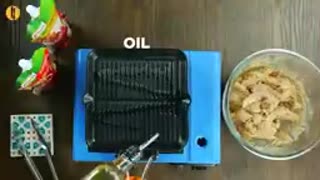Premium Only Content

SFBB Pack Training - Separating Foods ESL Food Safety Training
**Separating foods** is a key concept in food safety training covered in the **Safer Food, Better Business (SFBB)** pack. For **ESL (English as a Second Language) learners**, it’s crucial to break the topic into simple language with clear examples and visuals. Here’s a guide tailored for ESL food safety training:
---
### **What Does "Separating Foods" Mean?**
Separating foods means keeping different types of food apart to stop bacteria or allergens from spreading. This is important for keeping food safe to eat.
---
### **Why Is Separating Foods Important?**
- It **prevents cross-contamination**, which happens when harmful bacteria from raw food spread to other foods.
- It protects people with **allergies** by stopping allergens (like nuts) from touching other foods.
- It keeps food **safe and fresh** for longer.
---
### **Key Areas for Separating Foods**
1. **In the Fridge:**
- Always store raw meat, fish, and poultry **on the bottom shelf** in sealed containers to stop juices from dripping.
- Keep ready-to-eat foods (e.g., salads, cooked food) on **higher shelves**.
2. **During Preparation:**
- Use **different cutting boards and knives** for raw and cooked foods.
- Example: Use a red board for raw meat and a green board for vegetables.
- Keep raw and cooked foods apart on worktops and plates.
3. **During Storage:**
- Use separate, sealed containers for different foods.
- Label containers to avoid mixing allergens or raw and cooked foods.
4. **During Serving:**
- Use clean utensils for each dish.
- Do not let raw food touch cooked food on the same plate.
---
### **How to Separate Foods Safely (SFBB Guidance)**
1. **Color-Coded Equipment:**
- Use color-coded chopping boards and utensils:
- **Red:** Raw meat.
- **Blue:** Raw fish.
- **Green:** Vegetables and fruits.
- **Yellow:** Cooked meat.
- This makes it easy to know which tools are for what food.
2. **Hand Washing:**
- Wash hands with soap and warm water after touching raw food.
- Wash hands before touching cooked food or ready-to-eat items.
3. **Proper Containers:**
- Store raw foods in **leak-proof containers**.
- Cover all food with lids or plastic wrap.
4. **Cleaning and Sanitizing:**
- Clean all surfaces, cutting boards, and utensils with hot, soapy water or disinfectant after use.
- Use disposable cloths or wash reusable ones regularly.
---
### **Practical Activities for ESL Learners**
1. **Role-Playing Scenarios:**
- Example: Practice putting food in the fridge in the right order.
- Use a diagram of a fridge and let learners place food items in the correct spots.
2. **Matching Game:**
- Match cutting boards or utensils with the correct food (e.g., red cutting board for raw meat).
3. **Visual Posters:**
- Use images or infographics to show how to separate foods in the fridge, during prep, and while serving.
4. **Question and Answer Practice:**
- Example: "Where do you store raw chicken in the fridge?"
- Answer: "On the bottom shelf in a sealed container."
---
### **Simple Phrases to Teach**
- "Raw meat goes on the bottom shelf."
- "Use a red board for raw meat."
- "Wash your hands after touching raw food."
- "Do not mix raw and cooked food."
---
### **Reviewing Understanding**
- Ask learners to explain why separating foods is important.
- Provide a short quiz with questions like:
- "Where do you store cooked food in the fridge?"
- "Can you use the same knife for raw chicken and vegetables? Why?"
---
### **Extra Tips for Teaching ESL Learners**
- **Speak slowly and clearly.**
- Use **visual aids** like diagrams and photos.
- Repeat key points and allow learners to practice.
- Encourage **questions** to ensure understanding.
Would you like help creating visual guides, quizzes, or worksheets for this training?
-
 1:35
1:35
HSESafetyInformation
6 months agoMutton Chops two ways- baked & grilled Recipe by Food Fusion (Eid Recipe)
67 -
 LIVE
LIVE
TundraTactical
2 hours agoFudd Finder : 11 Questions Second Amendment Questions (And Roasts) to Ask Your Friends
42 watching -
 LIVE
LIVE
Silver Dragons
1 hour agoGold Price NEW ALL TIME HIGH - $5,000 GOLD NEXT?
67 watching -
 LIVE
LIVE
LFA TV
10 hours agoLFA TV ALL DAY STREAM - FRIDAY 9/5/25
1,302 watching -
 13:43
13:43
The Kevin Trudeau Show Limitless
2 days agoClassified File 3 | Kevin Trudeau EXPOSES Secret Society Brainwave Training
83.9K16 -
 1:11:24
1:11:24
vivafrei
5 hours agoDearborn Heights Police Have Been CONQUERED! Gender Madness on PASSPORTS! Canada Stuff & MORE!
75K28 -
 1:44:43
1:44:43
The Quartering
4 hours agoConservative Scam Busted, Black Fatigue Hits Airlines, Kimmel Meltdown
96.5K35 -
 LIVE
LIVE
Tudor Dixon
43 minutes agoRFK Jr., Big Pharma, and the Hidden Risks of SSRIs in Pregnancy | The Tudor Dixon Podcast
57 watching -
![MAHA News [9.5] RFK Lights Up Congress, CDC House Cleaning, Fight Over Vax Mandates For School Children](https://1a-1791.com/video/fww1/b9/s8/1/i/h/m/f/ihmfz.0kob-small-MAHA-News-9.5.jpg) LIVE
LIVE
Badlands Media
12 hours agoMAHA News [9.5] RFK Lights Up Congress, CDC House Cleaning, Fight Over Vax Mandates For School Children
514 watching -
 DVR
DVR
The Tom Renz Show
1 hour agoWho Is Undermining Trump?
3.33K2